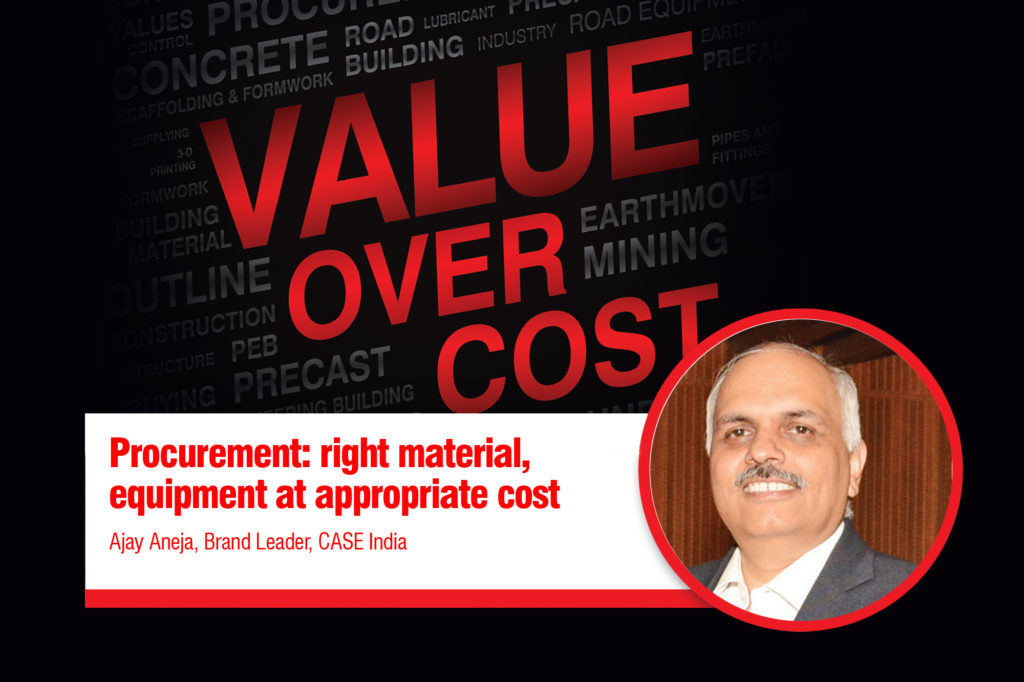The project procurement cycle entails procurement activities from the decision to purchase the material or service till the payment of bills and closing of procurement on scheduled time. A project manager’s prime task is not only to keep a check on timely delivery or smooth functioning of departments, but also to decide right material and equipment at the right cost.
“Gathering customer’s insights on defining and improving the products are at the core of CASE’s business. We prioritise modifying our products according to the trending technology for optimum service, simultaneously keeping our regular maintenance, on-ground check, after sales services and feedbacks ongoing,” according to Ajay Aneja, Brand Leader, CASE India.
This helps the company to understand customer requirements and modify offerings accordingly. The customer who sometimes is the person responsible for procurement sees the value in the process which helps him make an informed decision.
“We invite our customers to participate in defining and improving new products and call this customer-driven product definition (CDPD) process. We involve CASE and competitive customers in CDPD projects to help us better understand their needs, and work with us to develop and test new models that respond to those needs,” he said.
Value-added features
Providing value-added features in products and services to customers is a prime focus area at CASE. The process of integrating customers’ feedback results in construction machines that not only deliver great performance and efficiency, but also meet the identified needs of the operators who use the equipment.
“We have used the CDPD process in developing our most recent line of loader or backhoes and skid steer loader. Customer input has guided improvements in serviceability, visibility, stability, power, ease of transport, extended time between refueling, noise reduction and cold-weather starting, just to name a few. Practices like CDPD motivate customers to focus on value over cost,” he said.
“The latest technology is CASE India’s revolutionary EAGLE EYE telematics solution, present in CASE’s loader backhoe, for enhancing the performance and efficiency of the machine,” according to Aneja.
This monitoring system helps the operator know machine movements resulting in reduced accidents. This IoT-based asset monitoring system gives the freedom of machine monitoring and remote diagnostics alerts at the click of a button on a mobile or desktop computer. Further, CASE India is constantly working on software-based robust solutions to meet modern customer needs and requirements.
Driving value offering
Government’s ‘Make in India’ is aiding building of quality infrastructure giving impetus to the manufacturing sector by the means of incentives.
The company’s manufacturing plant is in Pithampur area, Indore (Madhya Pradesh) where it produces construction equipment range. From CASE’s Pithampur plant, products are being exported to the markets of Africa, South East Asia, Russia, Sri Lanka, Bhutan and Middle East countries.
“The plant has recently been certified Bronze Level in the World Class Manufacturing (WCM) program. WCM is one of the global manufacturing industry’s highest standards for the integrated management of manufacturing plants and processes. The Pithampur facility serves India’s road and infrastructure sector and exports its products to some 30 markets. As a result of this local manufacturing expertise, the CASE brand has been India’s market leader in vibratory compactors and a leading player in loader backhoes for over 25 years,” he added.
Practices like customer-driven product definition (CDPD) motivate customers to focus on value over cost.
Ajay Aneja, Brand Leader, CASE India
Cookie Consent
We use cookies to personalize your experience. By continuing to visit this website you agree to our Terms & Conditions, Privacy Policy and Cookie Policy.


















